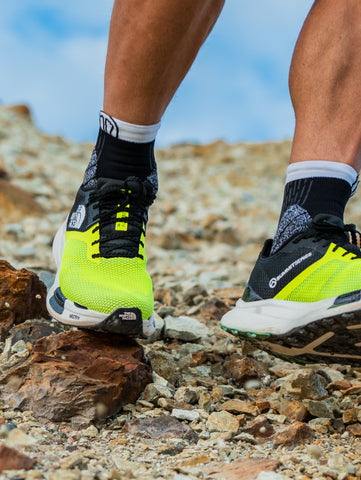Do socks really make a difference?
Yes, socks can make a significant difference in trail running. High quality socks are crucial for trail running, as often you will be covering distance over rugged terrains, uneven surfaces, and varying weather conditions, which can put extra stress on your feet.
The right pair of socks can provide several benefits that enhance your comfort, performance, and overall experience on the trails. Here are a few ways in which socks can make a difference:
Moisture Management: Trail running often involves challenging terrain and varying weather conditions, which can result in sweaty feet. High quality trail running socks are designed with moisture-wicking properties, meaning they can quickly draw sweat and moisture away from your skin and towards the outer surface of the sock. This helps keep your feet dry, reducing the risk of blisters, discomfort, and fungal infections.
However, during longer 'Ultra' distances it is highly recommended to remove your socks, dry your feet and change into a fresh, dry pair of socks and shoes/ or insole, where possible. These measures will help prevent 'foot rot' or maceration of the skin due to excessive moisture.
Cushioning and Protection: As we know trails are, generally, pretty uneven, with rocks, roots, and other obstacles. Quality trail running socks offer extra cushioning in strategic areas, such as the heel, toe, and ball of the foot. This cushioning provides impact absorption and helps protect your feet from the repetitive pounding they endure during a trail run.
Sidas trail running socks also provide protective zones around the ankle. These areas of cushioning help reduce the risk of bruising or injury caused by sharp objects on the trail.
Blister Prevention: Blisters are a common issue in trail running due to the combination of moisture and friction. Our high-quality socks can minimise friction by:
Fitting snugly, our trail running socks act like an 'exoskeleton' around your feet, to reduce sock movement against the skin. Using Grip Yarn in strategic zones to grip the insole and reduce excessive 'mirco-movements' with your footwear. These features help in reducing the likelihood of blisters forming.
Temperature Regulation: Trail running can expose you to various temperatures and weather conditions. Good trail running socks are often made from moisture-wicking, breathable materials that help regulate temperature. They can keep your feet cool in hot weather by allowing heat to escape and provide insulation in colder conditions to keep your feet warm.
Arch Support and Stability: Running on uneven trails requires stability and support. Many trail running socks feature compression zones or built-in arch support to provide a snug and secure fit. This can help reduce foot fatigue and enhance overall stability during your run.
Durability: Trail running can be tough on socks, with constant rubbing against abrasive surfaces. High quality trail running socks are typically made from more durable and technical materials and have reinforced areas, such as the heel and toe, to withstand the rigors of off-road running. They are less likely to wear out quickly or develop holes, ensuring they last longer.
There will be a difference in price point for high quality socks such as the use of Polyamide (more durable, smooth, soft & comfortable to wear and resilient to stretching and UV) over Polyester, additional features such as high needle count in the kniting of the socks, grip zones, reinforced areas or European manufacturing etc.
All of the above features are found in our sock collection.

In summary, good socks are essential for trail running to provide moisture management, cushioning, protection, blister prevention, temperature regulation, arch support, stability, and durability.
Investing in high-quality trail running socks can significantly enhance your comfort, performance, and enjoyment on the trails.
Check out our range of tried, tested and trusted socks used by some of the worlds best trail & ultra runners!






